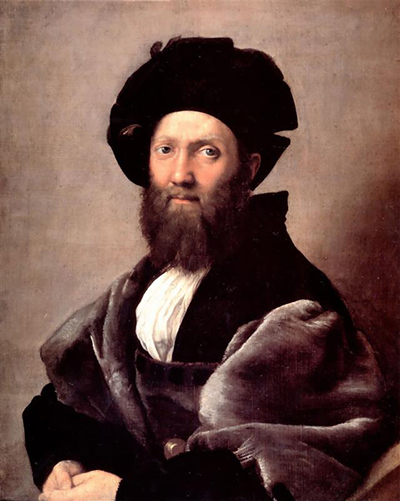Portrait of Baldassare Castiglione by Raphael is a circa 1514/1515 oil painting. It is regarded as one of the great Renaissance portraits and has an enduring influence.
The portrait depicts Raphael's friend, Baldassare Castiglione, who was a diplomat and humanist and considered quintessential High Renaissance gentleman example. The painting was designed as a result of the friendship between Raphael and Castiglione, whose rise in courtly circles matched that of the artist. By 1504, they were close friends; this is when Castiglione made his 2nd visit to Urbino, just as Raphael was gaining acknowledgement as a respected artist in the city's ducal court humanist circle.
Guidobaldo da Montefeltro commissioned Raphael to paint a portrait for Henry VII in 1505. Castiglione went to England and presented the finished picture to the king. It's possible that later Castiglione served as the scholarly advisor for The School of Athens by Raphael, and that the Zoroaster depiction in that fresco might be the courtier's portrait.
In the painting, Castiglione is seen seated against the earth-toned background, and he's wearing a dark doublet that has a squirrel fur trim and black ribbon. Also, on Castiglione's head, there's a turban that's covered by a notched bere. This attire indicates that the picture was done during the winter, probably that of 1514 to 1515, when Castiglione had gone to Rome by Guidobaldo da Montefeltro appointment to Pope Leo X, born Giovanni di Lorenzo de' Medic. The lightest areas in the painting are the face of the subject seen almost head-on, a white shirt billow front at his chest plus his two folded hands, which are essentially cropped at the canvas bottom edge. Castiglione is perceived as vulnerable, and possess Raphael's later portrait humane sensitivity characteristic. The soft contours of Castiglione's attire and rounded beard show the subtlety of the personality of the subject.
The painting may have had an intimate and practical purpose. Castiglione left his lovely family behind when he had gone to Rome; he wrote a poem whereby he imagined his son and wife consoling themselves with the painting during his absence. The picture's composition is pyramidal. It is one of the only 2 paintings by Raphael on canvas, and before it was regarded as originally produced on a wood panel, then transferred to canvas. The copies that were produced in the seventeenth century show the hands of Castiglione in full, which suggests the painting was afterwards cut at the bottom by several inches (later, researchers determined it wasn't cut).
The elegance of execution in the painting is consistent with the subject's attitude. Lawrence Gowing, an art historian, remarked on the counterintuitive handling of the grey velvet as opposed to an academic form modelling, with the broad surfaces covered in rich darkness plus the fabric shining brightly as it's turning away from the light. Gowing stated that the painting has the delicacy of baroque observation and the noble contour and stillness of classic picture at its peak.
The atmospheric quality and composition of the painting suggest a recognition to the Mona Lisa painting, which Raphael saw in Rome. Although the portrait of Castiglione transcends questions about the influence, an American art historian called James Beck wrote stating that this painting stands as a final answer for single male portraiture that is within the Renaissance style.




